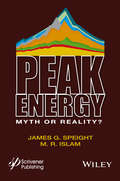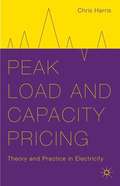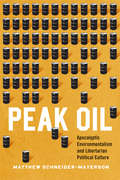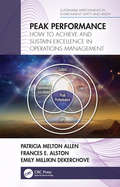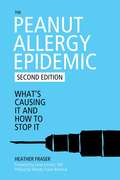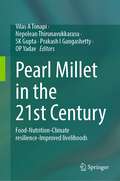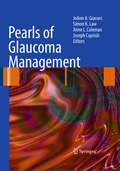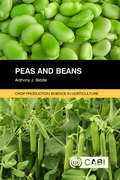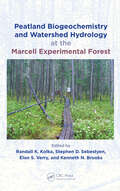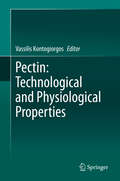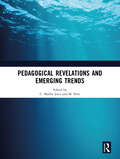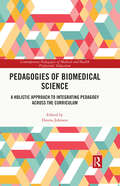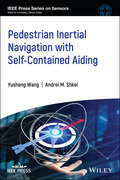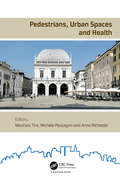- Table View
- List View
Peak Energy: Myth or Reality?
by James G. Speight M. R. IslamDoes the Earth contain enough oil to provide energy for the human race indefinitely? If not, how long will the oil last? What about renewable energy technologies like wind and solar? Will they be able to supply an indefinite supply of energy for the human race? If not, how long will it last? And what role does overpopulation play in our world's energy supply? Even with multiple forms of energy available, how long will it last as long as more and more humans, and therefore more industries and energy consumption, are added? Taking a long-held theory called "Peak Oil Theory" the authors of this groundbreaking new text examine the theory of "Peak Energy" to examine all of these questions. Crude oil and natural gas are the major sources of fuel used to supply energy for various needs. Users of crude oil and natural gas must take into account that these energy sources are, without doubt, non-renewable depleting resources, and the cost of extraction depends not only on the current rate of production but also on the amount of cumulative production. In fact, many pundits believe projections that the world is rapidly apprpaching a precipice, after which crude oil and natural gas will no longer be in ready supply. This phenomenon has given rise to the peak oil theory - peak oil is the point in time when the maximum rate of petroleum recovery from the reservoir is reached, after which the rate of petroleum production enters terminal decline. From this concept has emerged the wider concept of the peak energy theory which, as it is related to the availability of all fossil fuels, is also subject to decline with fossil fuel use. This text, written by two of the world's most well-known, respected, and prolific writers in the energy industry, is a fascinating study of our world's energy needs and the future of the multi-source energy supply on this planet. Whether oil and gas, wind, solar, geothermal, or even nuclear, all sources of energy have their limits, and we, as scientists, engineers, and consumers of energy need to be knowledgeable on these topics. This book is a must-have for any engineer, student, scientist, or even layperson interested in energy and the idea of energy sustainability on planet Earth.
Peak Load And Capacity Pricing
by Chris HarrisPeak Load and Capacity Pricing lays out clear pricing strategies for understanding peak load and capacity pricing structures, further cementing electricity's role as an asset class with fixed and variable costs. This work presents a global recasting of electricity market design, and it will be of direct use to practitioners, academics, commentators, planners, and policy makers in electricity. Harris places electricity firmly in the canon of the microeconomics and econo-engineering of pricesetting, from bridges to other infrastructure assets. His findings and research offer a fresh alternative to prevailing policies and regulations.
Peak Oil: Apocalyptic Environmentalism and Libertarian Political Culture
by Matthew Schneider-MayersonIn recent years, the concept of "peak oil"--the moment when global oil production peaks and a train of economic, social, and political catastrophes accompany its subsequent decline--has captured the imagination of a surprisingly large number of Americans, ordinary citizens as well as scholars, and created a quiet, yet intense underground movement. In Peak Oil, Matthew Schneider-Mayerson takes readers deep inside the world of "peakists," showing how their hopes and fears about the postcarbon future led them to prepare for the social breakdown they foresee--all of which are fervently discussed and debated via websites, online forums, videos, and novels. By exploring the worldview of peakists, and the unexpected way that the fear of peak oil and climate change transformed many members of this left-leaning group into survivalists, Schneider-Mayerson builds a larger analysis of the rise of libertarianism, the role of oil in modern life, the political impact of digital technologies, the racial and gender dynamics of post-apocalyptic fantasies, and the social organization of environmental denial.
Peak Performance: How to Achieve and Sustain Excellence in Operations Management (Sustainable Improvements in Environment Safety and Health)
by Patricia Melton Allen Frances E. Alston Emily Millikin DeKerchoveThe key to success and reaching peak performance is integrating three processes to optimize business through the use of human performance improvement tools, lean thinking, operational excellence, along with a strong organizational culture as the underpinning. These components form the basis of the Peak Performance Model. The tools presented in this book, along with the case studies, demonstrate how the model is applied and integrated into company practices. Companies and organizations want to improve their performance, but many have not integrated the right tools and processes. Through the application of the Peak Performance Model, every company can achieve and sustain Peak Performance.
Peak-to-Peak Output Current Ripple Analysis in Multiphase and Multilevel Inverters
by Jelena LoncarskiThe book introduces an original and effective method for the analysis of peak-to-peak output current ripple amplitude in three-phase two-level inverters. It shows that the method can be extended to both multiphase inverters, with particular emphasis on five-phase and seven-phase inverters, and multilevel ones, with particular emphasis on three-level inverters, and provides, therefore, a comparison among different number of output phases and voltage levels. The work reported on here represents the first detailed analysis of the peak-to-peak output current ripple. It makes an important step toward future developments in the field of high-power generation, and in grid-connected and motor-load systems.
Peaks and Troughs: In at the Deep End, High in the Hills
by Nick PerryA memoir of two brothers using an unexpected inheritance to start an organic farm in 1970 Wales: &“This is Bill Bryson with muck under the fingernails.&” —Brian Morton Londoners Nick Perry and his brother Jack were stuck in a bit of a rut. Nick, in his early twenties with a wife of infant twins, had been jumping from job to job; Jack chauffeured passengers around for their uncle&’s business. Then an aunt they barely remembered, to their complete surprise, left them a tidy sum of money. It didn&’t take long to come up with an idea—buying a plot of farmland in North Wales. Little did they know what a different world they were entering, and what a challenge it would be to find a way to farm that was in harmony with the earth and the animals in their care. The neighbors have little sympathy as Nick deals with the elements and with his nagging self-doubt. But no matter how close to the edge he and his family come, he carries on—and in this war-hearted, humorous, and ultimately inspirational tale, he tells the full story of a young man&’s attempt to run an organic farm in the unforgiving Welsh hills.
Peaks, Spikes, and Barrels: Modeling Sharp Movements in Oil Prices
by Alun Thomas Martin Mühleisen Malika PantA report from the International Monetary Fund.
Peanut Allergy Epidemic
by Janet Levatin Heather Fraser Woody Fraser-BoychuckEssential Reading for Every Parent In the early 1990s, tens of thousands of children with severe peanut and food allergies arrived for kindergarten at schools in Canada, the United Kingdom, Australia, and the United States. The phenomenon of a life-threatening allergy in kids in only these countries occurred simultaneously, without warning, and it quickly intensified. The number of peanut allergic children in the United States alone went from virtually none to about two million in just twenty years. As these children have aged, the combined number of American adults and children allergic to peanuts has grown to a total of four million. How and why has this epidemic occurred? In The Peanut Allergy Epidemic, Heather Fraser explains: Precisely when the peanut allergy epidemic began How a child-specific allergy epidemic happened before, at the close of the nineteenth century That in the early twentieth century doctors including the 1913 Nobel Prize in medicine winner identified vaccination as the cause of the first pediatric allergy epidemic impacting 50 percent of children That more than one hundred years of medical literature describes how vaccination creates allergy to what is in the shot, air, or body at the time of injection How changes in US vaccination legislation sparked the allergy epidemic in children Fraser also highlights alternative medicines and explores issues of vaccine safety and other food allergies, making this fully updated second edition a must-read for every parent, teacher, and health professional.
Peanut Processing Characteristics and Quality Evaluation
by Qiang WangThis book systematically covers the sensory, physical, chemical nutrition, and processing characteristics of different peanut varieties, while also providing an in-depth review of research advances in peanut processing quality. The book goes on to examine the relationship between raw materials and the qualities of peanut protein, peanut oil and other main peanut processing products. As such, it provides a valuable reference guide for research into the raw materials, change mechanisms and control technologies used in peanut processing, laying the groundwork for the development of new disciplines in "grain and oil processing quality". It will be useful for graduate students, researchers, and management groups from multidisciplinary audiences, covering both food science & technology and public health.
Pearl Millet in the 21st Century: Food-Nutrition-Climate resilience-Improved livelihoods
by Vilas A Tonapi Nepolean Thirunavukkarasu Sk Gupta Prakash I Gangashetty Op YadavThis book documents the global pearl millet research for achieving the sustainable development goals in the eve of International Year of Millets in 2023 by FAO. This book offers perspectives on the recent advances in the field of genomics, next-generation breeding approaches, hybrid development, crop production and protection technologies of pearl millets. Pearl millet is the world’s most important millet grown in the hot, semi-arid ecologies of Asia and Africa with versatile end uses. Of all the world’s cereals, pearl millet ranks the sixth most important crop after rice, wheat, maize, barley and sorghum. In the changing climatic condition, it can be pitched as strategic crop for food and nutritional security owing to its ability to survive in harsh ecologies and the higher micro-nutrients grain content. This books focuses on nutritional importance, climate resilience, seed systems, value-addition and market policies to enhance the genetic gain of pearl millets under marginal and favorable ecologies, and way forward for a food and nutrition secure world. It is a useful reading material for researchers and professionals working on small grains, millets and their cultivation and nutrition related aspects.
Pearl Millet: A Resilient Cereal Crop for Food, Nutrition, and Climate Security (Agronomy Monographs)
by Mahalingam Govindaraj Abdou Tenkouano C. Tara Satyavathi Ramasamy Perumal P. V. Vara PrasadIn this age of climate change, discover how pearl millet is considered a viable alternative cereal crop for semi-arid and hot areas Pearl millet, a warm-season, dryland cereal crop, is a staple food for over 90 million people in Africa and Asia. Its nutritional superiority relative to other cereal crops, such as rice, wheat, maize, and sorghum, and its hardiness and adaptability to harsh environments and poor soils make it a potentially life-saving resource for poor populations and/or areas hit by damaging climatic conditions. With climate change Placing an ever-greater strain on global agrifood systems, pearl millet has never been a more important crop in the fight against poverty, hunger, and malnutrition. Pearl Millet offers a thorough introduction to this potentially vital grain. Coming on the heels of a 2023 United Nations declaration of the “International Year of Millets,” it is a crucial intervention in an essential humanitarian project. It is the first comprehensive book on the subject to appear in print. Key Features: Analysis of a potential lead crop for climate-change-affected areasDetailed coverage of all pearl millet’s unique features, such as inherent genetic diversity, gluten free applications, and suitability for double croppingAn author team with vast research and crop development experience Pearl Millet is ideal for advanced undergraduate and graduate students, certified and practicing professionals, as well as industry and academic researchers.
Pearlite in Steels
by Harshad K. BhadeshiaPearlitic steel is the strongest commercially available mass-produced alloy, and pearlite is used in a myriad of applications, from the reinforcement of tyres in every single road vehicle in the world, to the creation of pathways across troubled waters. Pearlite in Steels is the first book dedicated to this vast subject. The book uniquely covers the topic in depth, providing a comprehensive coverage of fundamentals and technologies that make pearlite vital as an engineered material.• Covers the 3D-structure of pearlite over a wide range of length scales.• Details the relationship between imperfect structure and consequences.• Discusses all aspects of structure and complex properties.• Covers the evolution of structure during traumatic processing.• Engineering aspects are highlighted: the twisting of pearlitic wires, for the safe application of the strongest of ropes in safety-critical scenarios.• Highlights difficulties and inconsistencies, thereby helping to develop research.Aimed at materials engineers and metallurgists, this book by a leading global authority on the subject offers readers the deepest and broadest overview of pearlite in steels to date.
Pearls of Glaucoma Management
by Simon K. Law Joann A. Giaconi Joseph Caprioli Anne L. ColemanThis concise and comprehensive guide is written by international experts of the field who are familiar with the world's literature. Based on the world's literature and their own experience, authors state and explain how they prefer to manage patients and problems clinically. Each chapter author gives the reader numerous clear and specific tips and pearls for the diagnosis and management of Glaucoma. The reader-friendly structure of this lavishly illustrated 4-colour book ensures that the necessary information is quickly found and remembered. This book ensures a pleasant learning experience on Glaucoma management with the goal of an improved treatment outcome.
Peas and Beans
by Anthony J. BiddleThis practical book provides an accessible overview of all aspects of pea and bean production, including botany and physiology, breeding, agronomy, weed management, pests and diseases, harvesting, nutritional value and uses. It also reflects on the constraints and opportunities in the future for peas and beans, exploring their role in food sustainability and crop rotation, and various factors affecting supply and demand such as climate change and breeding technologies. Peas and beans are crops of economic, social and agronomic importance and this volume provides the specialist knowledge needed to ensure good quality standards are met. It includes: #65533; coverage of the main types of peas and beans grown on a significant scale or commercially produced in large area farming; #65533; key information relating to the role of peas and beans in biological nitrogen fixation; #65533; extensive coverage from the technology of cultivation to postharvest industry; and #65533; high-quality photos, presented in full colour throughout. Authored by a recognized authority with extensive experience in applied research, this book is an ideal resource for practical agronomists, advisors and producers, extension workers, horticulture students and all those involved in the production of peas and beans.
Peas and Beans: A Color Handbook (Crop Production Science in Horticulture)
by Anthony J BiddleThis practical book provides an accessible overview of all aspects of pea and bean production, including botany and physiology, breeding, agronomy, weed management, pests and diseases, harvesting, nutritional value and uses. It also reflects on the constraints and opportunities in the future for peas and beans, exploring their role in food sustainability and crop rotation, and various factors affecting supply and demand such as climate change and breeding technologies. Peas and beans are crops of economic, social and agronomic importance and this volume provides the specialist knowledge needed to ensure good quality standards are met. It includes: · coverage of the main types of peas and beans grown on a significant scale or commercially produced in large area farming; · key information relating to the role of peas and beans in biological nitrogen fixation; · extensive coverage from the technology of cultivation to postharvest industry; and · high-quality photos, presented in full colour throughout. Authored by a recognized authority with extensive experience in applied research, this book is an ideal resource for practical agronomists, advisors and producers, extension workers, horticulture students and all those involved in the production of peas and beans.
Peatland Biogeochemistry and Watershed Hydrology at the Marcell Experimental Forest
by Kenneth N. Brooks Randall K. Kolka Stephen D. Sebestyen Elon S. VerryThe Marcell Experimental Forest (MEF) in Minnesota serves as a living laboratory and provides scientists with a fundamental understanding of peatland hydrology, acid rain impacts, nutrient and carbon cycling, trace gas emissions, and controls on mercury transport in boreal watersheds. Its important role in scientific research continues to grow as t
Pectin: Technological and Physiological Properties
by Vassilis KontogiorgosThis text presents the technological and physiological properties of pectin in an educational approach that encompasses all of the essential information a researcher needs to fully understand their function and use in foods. Utilizing basic information on pectin as well as recent technological advances, this book is designed to be the primary resource for individuals seeking out an up to date reference work covering all the necessary informational and functional aspects of pectin. Pectin: technological and physiological properties is the first book to fully focus on the introductory concepts on pectin. Individual chapters cover localization and function, the structural aspects of pectin, pectinases, isolation and characterization and recovery from agricultural wastes. Important current advances such as emulsions, films, digestion, metabolism and bioactive properties are also focused on. With its combination of vital basic information and technological advances, this book presents full and up to date coverage on this pectin and its many forms and uses in foods.
Pedagogical Revelations and Emerging Trends
by C. Sheeba Joice M. SelviICEM’24 was the second edition organized by Saveetha Teaching Learning Centre (STLC), Saveetha Engineering College, India. The confluence explored and enhanced the potential of Engineering Educators and Learners with the aim to provide a global platform to identify best practices in teaching and applaud the evolutionary aspects involved in reaching the zenith. It consisted of two keynote sessions and paper presentations under two tracks namely Technology Oriented Learner-Centric Teaching Learning and Industrial Collaboration in Teaching Learning. It proposed to publish research papers on theoretical analysis, experimental studies and innovation, concerning advanced techniques in the field of pedagogy.
Pedagogies of Biomedical Science: A Holistic Approach to Integrating Pedagogy Across the Curriculum (Contemporary Pedagogies of Medical and Health Professions’ Education)
by Donna JohnsonThis book confronts the continually evolving nature of biomedical science education by providing a robust account of learning pedagogies and best practice for scholars and researchers in the field.Rather than considering subdisciplines of biomedical science education separately, the volume takes a holistic approach and considers the complexities of teaching biomedical science as a whole, providing a nuanced overview of how a particular practice fits in such a course overall, as well as providing support for development within the reader’s own subdiscipline. Ultimately, this holistic approach allows for expansive discussion of relevant pedagogical approaches that will directly inform innovations in the contemporary teaching of biomedical science education.Novel in approach and underpinned by the latest in research innovations, this book will appeal to scholars, researchers and postgraduate students in the fields of medical education, higher education, and curriculum studies. Policy makers involved with health education and promotion as well as educational research will also benefit from the volume.
Pedagogy and Learning with ICT: Researching the Art of Innovation
by Bridget SomekhBridget Somekh draws on her experience of researching the introduction of ICT into education to look at ICT development over the last twenty years. The book provides a fascinating, in-depth analysis of the nature of learning, ICT pedagogies and the processes of change for teachers, schools and education systems. It covers the key issues relating to the innovation of ICT that have arisen over this period, including: the process of change educational vision for ICT teacher motivation and engagement the phenomenon of ‘fit’ to existing practices systemic constraints policy and evaluation of its implementation students’ motivation and engagement the penetration of ICT into the home online learning and the ‘disembodied’ teacher.
Pedagogy for Technology Education in Secondary Schools: Research Informed Perspectives for Classroom Teachers (Contemporary Issues in Technology Education)
by David Barlex P. John WilliamsThis book explores pedagogy appropriate for the secondary school technology education classroom. It covers the dimensions of pedagogy for technology with scholarly research, including information strongly related to practice. The book discusses the nature of technology courses in secondary schools across various jurisdictions and considers how they might be viewed with regard to different epistemological frameworks. The writing is informed by, but not limited to, research and strongly related to practice with acknowledged experts in the field of technology education contributing chapters supported by evidence from technology education research or other fields. The authors speculate on pedagogical possibilities in their areas of expertise in order to consider pedagogical possibilities and develop a view of where pedagogy for technology education should move and how teachers might respond in the way they develop their practice.
Pedestrian Dynamics: Mathematical Theory and Evacuation Control
by Pushkin KachrooHomeland security, transportation, and city planning depend upon well-designed evacuation routes. You can’t wait until the day of to realize your plan won’t work. Designing successful evacuation plans requires an in-depth understanding of models and control designs for the problems of traffic flow, construction and road closures, and the intangible human factors. Pedestrian Dynamics: Mathematical Theory and Evacuation Control clearly delineates the derivation of mathematical models for pedestrian dynamics and how to use them to design feedback controls for evacuations.The book includes: Mathematical models derived from basic principles Mathematical analysis of the model Details of past work MATLAB® code 65 figures and 400 equations Unlike most works on traffic flow, this book examines the development of optimal methods to effectively control and improve pedestrian traffic flow. The work of a leading expert, it examines the differential equations applied to conservation laws encountered in the study of pedestrian dynamics and evacuation control problem. The author presents new pedestrian traffic models for multi-directional flow in two dimensions. He considers a range of control models in various simulations, including relaxed models and those concerned with direction and magnitude velocity commands. He also addresses questions of time, cost, and scalability. The book clearly demonstrates what the future challenges are and provides the tools to meet them.
Pedestrian Inertial Navigation with Self-Contained Aiding (IEEE Press Series on Sensors)
by Andrei M. Shkel Yusheng WangExplore an insightful summary of the major self-contained aiding technologies for pedestrian navigation from established and emerging leaders in the field Pedestrian Inertial Navigation with Self-Contained Aiding delivers a comprehensive and broad treatment of self-contained aiding techniques in pedestrian inertial navigation. The book combines an introduction to the general concept of navigation and major navigation and aiding techniques with more specific discussions of topics central to the field, as well as an exploration of the future of the future of the field: Ultimate Navigation Chip (uNavChip) technology. The most commonly used implementation of pedestrian inertial navigation, strapdown inertial navigation, is discussed at length, as are the mechanization, implementation, error analysis, and adaptivity of zero-velocity update aided inertial navigation algorithms. The book demonstrates the implementation of ultrasonic sensors, ultra-wide band (UWB) sensors, and magnetic sensors. Ranging techniques are considered as well, including both foot-to-foot ranging and inter-agent ranging, and learning algorithms, navigation with signals of opportunity, and cooperative localization are discussed. Readers will also benefit from the inclusion of: A thorough introduction to the general concept of navigation as well as major navigation and aiding techniques An exploration of inertial navigation implementation, Inertial Measurement Units, and strapdown inertial navigation A discussion of error analysis in strapdown inertial navigation, as well as the motivation of aiding techniques for pedestrian inertial navigation A treatment of the zero-velocity update (ZUPT) aided inertial navigation algorithm, including its mechanization, implementation, error analysis, and adaptivity Perfect for students and researchers in the field who seek a broad understanding of the subject, Pedestrian Inertial Navigation with Self-Contained Aiding will also earn a place in the libraries of industrial researchers and industrial marketing analysts who need a self-contained summary of the foundational elements of the field.
Pedestrians, Urban Spaces and Health: Proceedings of the XXIV International Conference on Living and Walking in Cities (LWC, September 12-13, 2019, Brescia, Italy)
by Maurizio TiraToday, citizens advocate greater environmental sustainability, better services and the improvement of urban quality by promoting safer mobility and health. Addressing these issues, Pedestrians, Urban spaces and Health contains the papers presented at the XXIV International Conference "Living and Walking in Cities" (Brescia, Italy, 12-13 September 2019). The contributions discuss town planning issues, look at best practices and research findings across the broad spectrum of urban and transport planning, with particular attention to the safety of pedestrians in the city. The main topics of the book are: Walking experiences Urban spaces and Redevelopment Healthy cities (as Urban resilience and for Weakest users) Pedestrians, Urban spaces and Health is a powerful plea for a multi-disciplinary and comprehensive approach to urban mobility and planning, and will be of interest to academics, consultants and practitioners interested in these areas.
Pediatric Emergency Ultrasound: A Concise Guide
by Marsha A. Elkhunovich Tarina L. Kang Courtney Brennan Kathryn Pade Rashida Campwala Jessica Rankin Kristin BeronaThis concise, portable manual provides practitioners and future practitioners with a basic guide to pediatric emergency ultrasound, enabling them to learn the fundamentals of bedside ultrasound and use these to refresh their skills prior to, or when, performing it on a patient.
